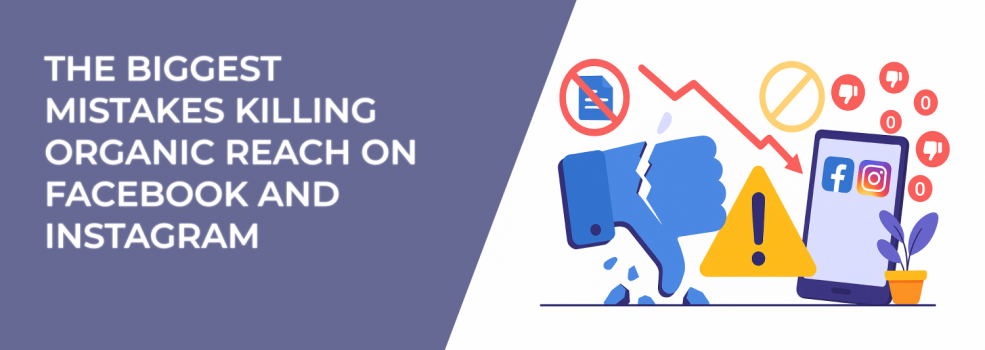Getting organic reach on Facebook and Instagram is tough these days, but it’s not impossible. Plenty of businesses still get attention without paying for every view. The problem is that many brands repeat the same mistakes — and those mistakes quietly crush their reach.
If you’ve been asking yourself why fewer people see your posts, the answer might be in the way you use these platforms. Let’s go through the most common errors and how to fix them.
1. Ignoring How the Facebook and Instagram Algorithms Work
Both platforms run on algorithms that decide what shows up in people’s feeds. They look at things like relevance, engagement, how quickly people react, and whether you post regularly. If you ignore this, your posts will struggle to get seen.
Why this hurts: Posts that don’t get engagement early are seen as boring. The algorithm shows them to fewer people, and reach drops even more. If you want to go deeper into how these systems decide what users see, check out How Algorithms Shape What Customers See (and What You Can Do About It).
How to fix it:
-
Post when your audience is online so your content gets quick engagement. If people start liking, commenting, or sharing within minutes, the algorithm takes that as a positive signal.
-
Use features like Reels and Stories — they’re pushed more by the platforms. When you adopt new tools, you benefit from the platform’s effort to promote them.
-
Keep a steady posting schedule so the system knows your account is active. Sporadic posting makes the algorithm think your page isn’t worth boosting.
Learning how the algorithm thinks may feel like a moving target, but keeping up with new formats and behaviors can make the difference between fading into the background and showing up consistently in your audience’s feed.
2. Posting Without a Content Strategy
Random posting feels unorganized to both your audience and the algorithm. Without a plan, your content lacks direction and results in weaker engagement.
Why this hurts: People like consistency. If your content doesn’t connect to a bigger story, they’ll stop paying attention. That means less engagement and less reach.
How to fix it:
-
Plan weekly themes that tie to your goals. For example, Mondays for product posts, Wednesdays for tips, Fridays for polls. A theme keeps your content varied but structured.
-
Create content in batches to stay ahead. When you plan and prepare in advance, you avoid last-minute weak posts that don’t perform.
-
Use a calendar to balance education, entertainment, and promotions. This ensures your page feels both useful and interesting, not just sales-driven.
A strategy doesn’t just keep you organized — it helps your audience know what to expect and keeps them coming back. For small businesses especially, building a clear structure can make a huge difference, as explained in Social Media Strategies Every Small Business Should Use to Build Engagement and Grow. When your content has a rhythm, people are more likely to stick around and interact.
3. Neglecting Audience Engagement
Some brands post and walk away. They don’t reply to comments or answer DMs. On social media, that’s a huge mistake.
Why this hurts: The algorithm rewards two-way conversations. If you don’t interact, your posts get fewer likes and comments, which lowers visibility.
How to fix it:
-
Spend a few minutes each day replying to comments and messages. A quick response shows your audience you care, and it encourages more people to interact.
-
Use features like polls or question stickers to get people talking. These tools invite feedback and spark natural conversations.
-
Show appreciation by engaging with customer posts that mention your brand. People love recognition, and it motivates them to engage with you more often.
Engagement isn’t just polite — it’s how you boost your organic growth and build stronger relationships. If you want practical ideas, check out 9 Ways to Improve Your Audience Engagement. The more you encourage real conversations, the more likely people are to return and interact with your brand in the future.
4. Chasing Virality Instead of Consistent Value
It’s tempting to post a meme or trending audio just to get quick attention. But if it has nothing to do with your brand, it doesn’t help in the long run.
Why this hurts: Viral posts may bring a spike, but it doesn’t last. People won’t connect your brand with real value, and your reach will fade again.
How to fix it:
-
Stick to content that matches your brand and helps your audience. When people see value, they return and engage more often.
-
Use trending formats, but combine them with useful tips, FAQs, or tutorials. This way, you get the benefit of trends without losing relevance.
-
Focus on posts people want to save or share, not just laugh at once. Saved content signals long-term value to the algorithm.
Virality feels exciting in the moment, but consistency wins the long game. When people know they’ll get real insights from you, they’ll stick with your content long after the trends fade.
5. Skipping Analytics and Performance Insights
Not checking analytics is like driving with your eyes closed. Facebook and Instagram give you plenty of data, but many brands ignore it.
Why this hurts: Without insights, you keep posting content that doesn’t work. That means wasted effort and fewer results.
How to fix it:
-
Track key metrics like reach, saves, and shares after every post. These numbers show you what content really resonates.
-
Test different content types and see which ones perform best. Don’t assume videos always beat photos or vice versa — check your data.
-
Post when your analytics show your audience is most active. Timing can make or break your engagement rate.
Want a deeper framework for analyzing performance? See How to Analyze Facebook Ad Performance Beyond CTR and CPC. The same principles apply to organic posts. Understanding your analytics gives you the power to adjust before wasting more time on content that doesn’t connect.
6. Overusing Links in Posts
Dropping links in every caption usually backfires. Facebook and Instagram want users to stay on the app, so posts with external links get less exposure.
Why this hurts: Posts full of links are shown less often, which means fewer clicks and weaker reach.
How to fix it:
-
Share native content that doesn’t need a link to make sense. A post that stands alone will always get more attention.
-
Put links in Stories, bios, or pinned comments instead of captions. This way, you still drive traffic without hurting your reach.
-
Turn blogs into short carousels or videos, then point users to the full article later. Repurposing makes your content easier to consume in-platform.
Links aren’t bad — but when overused, they turn your content into exit doors that the algorithm avoids pushing. Strike a balance so your audience still finds value without constantly leaving the platform.
7. Reposting the Same Content Across Platforms
Copying the same content to both Facebook and Instagram saves time, but it hurts performance. The platforms have different audiences and behaviors.
Why this hurts: Instagram users want quick, visual-first content. Facebook users often prefer longer captions, groups, and videos. One-size-fits-all content doesn’t engage either group fully.
How to fix it:
-
Adapt your posts. Use Stories, Reels, and bold visuals on Instagram. Use longer text and groups on Facebook. Each platform should feel like you created content for it specifically.
-
Track results separately for each platform. You may find that the same idea works differently depending on how it’s presented.
-
Tweak your content idea instead of reposting the exact same thing. Even small changes in visuals or captions can make a big difference.
Tailoring your approach shows respect for how each audience consumes content. When people feel that effort, they’re more likely to engage with what you share.
8. Forgetting the Importance of Community
Some brands only promote, forgetting to actually build a community. That approach quickly kills organic reach.
Why this hurts: People don’t want to be sold to all the time. When they stop engaging, the algorithm shows your posts less often.
How to fix it:
-
Ask open-ended questions in your captions to start conversations. This helps people feel like they’re part of something, not just an audience.
-
Share user-generated content and credit your customers. Recognition builds loyalty and encourages others to share too.
-
Build Facebook Groups or use interactive Instagram features to create connection. Communities grow when people feel they belong somewhere.
For tips on building community-driven growth, read Get Your Facebook Group Noticed: Attract Members Who Actually Engage. Strong communities are what keep brands alive on social platforms — because people stick around when they feel heard and included.
Final Thoughts: Saving Your Organic Reach
Getting organic reach on Facebook and Instagram takes work. The key is avoiding the mistakes that bury your content.
-
Work with the algorithm, not against it. That means timing, consistency, and smart use of features.
-
Build a content strategy instead of posting randomly. Planning keeps your message clear and consistent.
-
Make engagement a habit, not an afterthought. The more you interact, the more your posts will spread.
-
Use analytics to guide every move. Numbers don’t lie — they tell you what your audience truly wants.
If you make these small changes, your content can get seen, shared, and remembered again. The question is: are you ready to put them into action?

